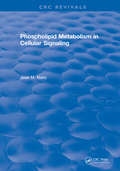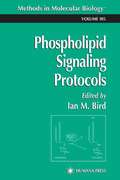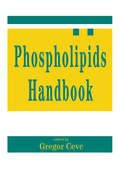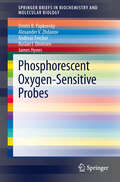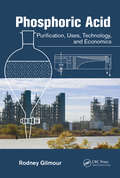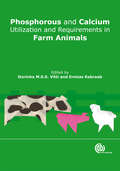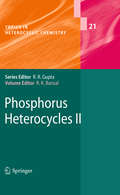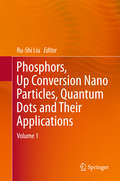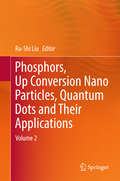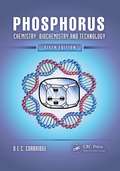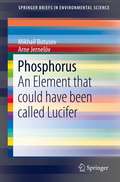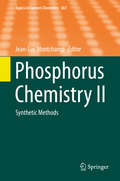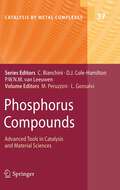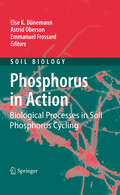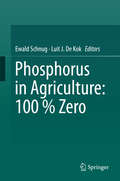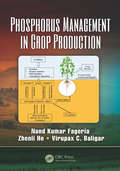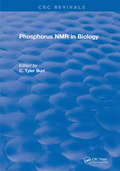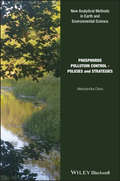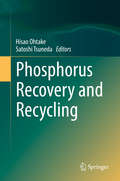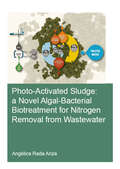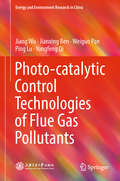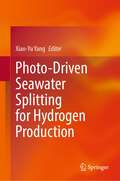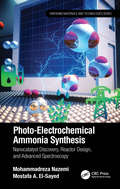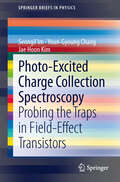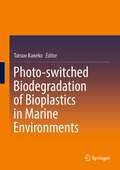- Table View
- List View
Phospholipid Metabolism in Cellular Signaling
by Jose M. MatoPhospholipids are no longer considered exclusively as the building blocks of biomembranes, but are now regarded to be exceptionally important to cellular signalling.Another conclusion resulting from studies over the past several years is that no single general scheme for the role of phospholipids during cell activation can be drawn as representative of all cells. This book presents a comprehensive view of the recent advances made in certain major research areas within the field of phospholipid metabolism in cellular signalling. Topics discussed within this volume include lipid composition of cellular membranes and their organization in biological systems, the dynamic aspects of phospholipid metabolism and its regulation by extracellular stimuli, and the role of newly discovered glycosyl-phosphatidylinositols in insulin action . The book also discusses two biologically active phospholipids: the sphingolipids, and ether-linked glycerophospholipids (the platelet activating factor). Phospholipid Metabolism in Cellular Signaling is an important research reference that should be considered required reading by all scientists and graduate students working on cell activation (e.g., growth factors, hormones, and oncogenes).
Phospholipid Signaling Protocols
by Ian BirdThis wide-ranging collection of state-of-the-art techniques for the assay of phospholipid and phospholipid-derived second messengers allows the identification and quantification of signal pathway activation. The assays described cover all the major phospholipases (C, D, A2), as well as sphingomyelinase and associated metabolites. Additional protocols are provided for the assay of phosphoinositide 3-, 4-, and 5-kinase activity and for the separation and identification of phospholipids, diacylglycerol and sphingolipids, as well as their phosphoinositol, choline, and fatty acid metabolites. Detailed, step-by-step instructions make this book suitable for both the newcomer and the experienced investigator.
Phospholipids Handbook
by Gregor CevcEmploying a multidisciplinary approach to phospholipid research, this work catalogues the current knowledge of this class of molecules and details the general, chemical, physical and structural properties of phospholipid monolayers and bilayers. Phospholipid applications are also covered.
Phosphorescent Oxygen-Sensitive Probes
by James Hynes Ruslan I. Dmitriev Dmitri Papkovsky Andreas Fercher Alexander V. ZhdanovBiological O2 sensing probes and measurement techniques were first introduced in the late 80s. In the last 3-5 years they have undergone major development that have made them available and affordable for a broad range of applications in various disciplines of the life and biomedical sciences. These new chemistries and technologies, which are significantly different from the majority of other fluorescence-based probes and detection techniques, have already demonstrated their high utility. This book will provide a systematic overview of the existing and emerging O2 sensing technologies in their different modifications, a practical guide to their rational selection and use, and examples of biological applications/case studies, including details on how to set up and conduct such experiments, troubleshoot and interpret the data.
Phosphoric Acid: Purification, Uses, Technology, and Economics
by Rodney GilmourThe rise and rationalization of the industrial phosphates industry have gone hand in hand with the development and maturation of technologies to purify phosphoric acid. In the 1960s and 70s, driven by the exponential sales growth of the detergent-builder sodium tripolyphosphate, chemical producers raced to develop processes that would provide a suf
Phosphorous and Calcium Utilization and Requirements in Farm Animals
by Ermias Kebreab Dorinha M. S. S. VittiThis book brings together quantitative aspects of phosphorus and calcium metabolism in farm animals in chapters written by leading researchers worldwide. It covers isotope dilution technique, phosphorus and calcium utilization in ruminants (sheep, goats and cattle) and non-ruminants (swine, horses) and recommended value of phosphorus and calcium inclusion in feed. It is an essential resource for researchers and students in animal sciences and nutrition.
Phosphors, Up Conversion Nano Particles, Quantum Dots and Their Applications
by Ru-Shi LiuThis book introduces readers to fundamental information on phosphor and quantum dots. It comprehensively reviews the latest research advances in and applications of fluoride phosphors, oxide phosphors, nitridosilicate phosphors and various quantum dot materials. Phosphors and phosphor-based quantum dot materials have recently gained considerable scientific interest due to their wide range of applications in lighting, displays, medical and telecommunication technologies. This work will be of great interest to researchers and graduate students in materials sciences and chemistry who wish to learn more about the principles, synthesis and analysis of phosphors and quantum dot materials.
Phosphors, Up Conversion Nano Particles, Quantum Dots and Their Applications
by Ru-Shi LiuThis book introduces readers to fundamental information on phosphor and quantum dots. It comprehensively reviews the latest research advances in and applications of fluoride phosphors, oxide phosphors, nitridosilicate phosphors and various quantum dot materials. Phosphors and phosphor-based quantum dot materials have recently gained considerable scientific interest due to their wide range of applications in lighting, displays, medical and telecommunication technologies. This work will be of great interest to researchers and graduate students in materials sciences and chemistry who wish to learn more about the principles, synthesis and analysis of phosphors and quantum dot materials.
Phosphorus: Chemistry, Biochemistry and Technology, Sixth Edition
by D.E.C. CorbridgeOver two decades have passed since the fifth edition of Phosphorus: Chemistry, Biochemistry and Technology. Major advances in chemistry, materials science, electronics, and medicine have expanded and clarified the role of phosphorus in both our everyday appliances and groundbreaking research. Significantly expanded, updated, and reorganized, this s
Phosphorus
by Arne Jernelöv Mikhail ButusovThis book starts with depiction of the phosphorus role in life creation and evolution. Then it outlines in which vital processes different phosphates participate in life of all flora and fauna, from DNA molecules till body tissues. Crucial function of phosphates was noticed long ago, but only in XIX century discovery of mineral fertilizers made it possible to sustain the needs of growing global population, thus initiating a "green revolution". Though, for many decades after it, the complexity of interactions "fertilizer-soil-plant roots" was underrated, causing massive damages, such as soil destruction and eutrophication of waters. Still, mining of exhausting natural phosphate reserves continued worldwide. Lessons of what happened in XIX century due to scarcity of phosphates were ignored. In the meantime, production of phosphates reached its peak few years ago. Immediate implementation of phosphate recycling technologies from municipal wastes can help avoid imminent global disaster.
Phosphorus Chemistry I
by Jean-Luc MontchampEach review within the volume critically surveys one aspect of that topic and places it within the context of the volume as a whole. The most significant developments of the last 5 to 10 years are presented using selected examples to illustrate the principles discussed. The coverage is not intended to be an exhaustive summary of the field or include large quantities of data, but should rather be conceptual, concentrating on the methodological thinking that will allow the non-specialist reader to understand the information presented. Contributions also offer an outlook on potential future developments in the field.
Phosphorus Compounds
by Luca Gonsalvi Maurizio PeruzziniEach chapter of Phosphorus Compounds: Advanced Tools in Catalysis and Material Sciences have been carefully selected by the editors in order to represent a state-of-the-art overview of how phosphorus chemistry can provide solutions in various fields of applications. The editors have assembled an international array of world-renowned scientists and each chapter is written by experts in the fields of synthetic chemistry, homogeneous catalysis, dendrimers, theoretical calculations, materials science, and medicinal chemistry with a special focus on the chemistry of phosphorus compounds. Phosphorus Compounds: Advanced Tools in Catalysis and Material Sciences is of interest to a general readership ranging from advanced university course students to experts in academia and industry.
Phosphorus in Action
by Astrid Oberson Else K. Bünemann Emmanuel FrossardPhosphorus (P) is a finite resource which is essential for life. It is a limiting nutrient in many ecosystems but also a pollutant which can affect biodiversity in terrestrial ecosystems and change the ecology of water bodies. This book collects the latest information on biological processes in soil P cycling, which to date have remained much less understood than physico-chemical processes. The methods section presents spectroscopic techniques and the characterization of microbial P forms, as well as the use of tracers, molecular approaches and modeling of soil-plant systems. The section on processes deals with mycorrhizal symbioses, microbial P solubilization, soil macrofauna, phosphatase enzymes and rhizosphere processes. On the system level, P cycling is examined for grasslands, arctic and alpine soils, forest plantations, tropical forests, and dryland regions. Further, P management with respect to animal production and cropping, and the interactions between global change and P cycling, are treated.
Phosphorus in Agriculture: 100 % Zero
by Ewald Schnug Luit J. De KokThe title 'Phosphorus in Agriculture: 100 % Zero' is synonymous for make-or-break. And it stands up to the promise. This book sends an important message as it delivers background information, intrinsic hypotheses, validation approaches and legal frameworks, all for balanced phosphorus fertilization in agriculture. This implies firstly that the phosphorus requirement of crop is fully satisfied by applying exclusively fertilizers which contain the nutrient in completely available form. Secondly, environmental demands through eutrophication and hazardous contaminants must not be compromised. The book identifies equally knowledge gaps and deficits in the transformation and implementation of research into practice. Bottom line is that research delivers the tools for a sustainable phosphorus management while legal frameworks are insufficient.
Phosphorus Management in Crop Production
by Nand Kumar Fageria Zhenli He Virupax C. BaligarThe world population is projected to reach nine billion by 2050, and in the coming years, global food demand is expected to increase by 50% or more. Higher crop productivity gains in the future will have to be achieved in developing countries through better natural resources management and crop improvement. After nitrogen, phosphorus (P) has more widespread influence on both natural and agricultural ecosystems than any other essential plant element. It has been estimated that 5.7 billion hectares of land worldwide contain insufficient amounts of available P for sustainable crop production, and P deficiency in crop plants is a widespread problem in various parts of the world. However, it has been estimated that worldwide minable P could last less than 40 years. For sustaining future food supplies, it is vital to enhance plant P use efficiency. To bring the latest knowledge and research advances in efficient management of P for economically viable and environmentally beneficial crop production in sustainable agriculture, Phosphorus Management in Crop Production contains chapters covering functions and diagnostic techniques for P requirements in crop plants, P use efficiency and interactions with other nutrients in crop plants, management of P for optimal crop production and environmental quality, and basic principles and methodology regarding P nutrition in crop plants. The majority of research data included are derived from many years of field, greenhouse, and lab work, hence the information is practical in nature and will have a significant impact on efficient management of P-fertilizers to enhance P use efficiency, improve crop production, promote sustainable agriculture, and reduce P losses through eluviations, leaching, and erosion to minimize environmental degradation. A comprehensive book that combines practical and applied information, Phosphorus Management in Crop Production is an excellent reference for students, professors, agricultural research scientists, food scientists, agricultural extension specialists, private consultants, fertilizer companies, and government agencies that deal with agricultural and environmental issues.
Phosphorus NMR in Biology
by C. BurtNMR is a technique that can spoil you. It is true that it is not as sensitive as some of the spectroscopic methods, but the quality of the information and the incredible ease of sample preparation make it one of the tools that have opened new vistas in biological research. This volume is intended to show how those vistas can range from the molecule to the microbe to man himself. Further, it is what prompts the rather broad title.
Phosphorus Pollution Control: Policies and Strategies (Analytical Methods in Earth and Environmental Science)
by Aleksandra DrizoPhosphorus Pollution Control – Policies and Strategies Deterioration and decline of water resources due to pollution caused by humans and their activities has become a universal health, environmental, social and economic problem. Excess discharges of nutrients, in particular, phosphorus, has been recognized as the most prevalent water pollution problem globally. Moreover, its perpetual occurrence and expansion creates imminent threats to water and food security. Despite extensive research during the past five decades, many key questions in eutrophication science remain unanswered. This book summarizes the most recent policies and strategies for phosphorus removal and recovery from municipal, residential and agricultural wastewater effluents and runoff into a concise and up-to-date volume. The book will be of interest to environmental and water resources scientists and engineers, consultants, policy makers, and practitioners working in the field.
Phosphorus Recovery and Recycling
by Satoshi Tsuneda Hisao OhtakeThis book focuses on the engineering aspects of phosphorus (P) recovery and recycling, presenting recent research advances and applications of technologies in this important and challenging area of engineering. It highlights full-scale applications to illustrate the performance and effectiveness of the new technologies. As an essential element for all living organisms, P cannot be replaced by any other element in biochemical processes, humans ultimately rely its availability. Today, P is mostly obtained from mined rock phosphate (Pi). However, natural reserves of high-grade rock Pi are limited and dwindling on a global scale. As such, there have been increased efforts to recycle P from secondary sources, including sewage sludge, animal manure, food waste, and steelmaking slag, and so close the anthropogenic P cycle. In addition to various aspects of phosphorus covered by other literature, including chemistry, biochemistry, ecology, soil-plant systems and sustainable management, this book is a valuable and comprehensive source of information on the rapidly evolving field of P recovery and recycling engineering for students, researchers, and professionals responsible for sustainable use of phosphorus.
Photo-Activated Sludge: A Novel Algal-Bacterial Biotreatment for Nitrogen Removal from Wastewater (IHE Delft PhD Thesis Series)
by Angélica Rada ArizaNitrogen rich wastewaters (10-400 mg N L-1) are usually produced by municipal, industrial and agricultural wastes, such as effluents from anaerobic treatments. These represent a risk to the environment due to the high nutrient concentrations (nitrogen and phosphorous), which can cause eutrophication of water bodies, deteriorating the quality of the ecosystems. As a solution, the potential nitrogen removal capacity of a novel bio-treatment system, namely the Photo-Activated Sludge (PAS), which is composed of microalgae and bacteria consortia, is presented in this thesis. <P><P>This novel bio-treatment is based on the symbiosis between microalgae, nitrifiers and heterotrophic bacteria (microalgal-bacterial consortia). Experimental work using photobioreactors for the cultivation of microalgae and bacteria under sequencing batch conditions showed that microalgal-bacterial consortia can remove ammonium 50% faster than solely microalgal consortia. The increase in ammonium removal rates was due to the action of nitrifying bacteria, supplied with oxygen produced by algae. Nitrification was the main ammonium removal mechanism within the microalgal-bacterial biomass, followed by algal uptake and nutrient requirements for bacterial growth. Carbon oxidation and denitrification were the main removal mechanisms for organic carbon. Hence, the role of algae within the microalgal-bacterial system is to provide oxygen to support the aerobic processes. The microalgal-bacterial system offers the possibility of reducing the hydraulic retention time, which can decrease the large area requirements often demanded by algal systems.
Photo-catalytic Control Technologies of Flue Gas Pollutants (Energy and Environment Research in China)
by Jiang Wu Jianxing Ren Weiguo Pan Ping Lu Yongfeng QiThis book introduces the theory and applications of nanometer photocatalysis, and it briefly presents the concept of photocatalysts, photocatalytic reaction mechanisms and kinetics, and photocatalytic reactor design. In addition, the use of photocatalysis in the control of flue-gas pollutants is discussed in detail.The book also describes how a photocatalytic reactor is designed and implemented to evaluate the photocatalytic oxidation capacity of different photocatalysts on elemental mercury in a simulated flue gas. After that, the effect of photocatalysts on the SO2, NOx and Hg removal in the flue gas is studied. Photocatalytic cleaning technology can be applied not only in gas pollutant cleaning at power plants, but also in wastewater purification.Readers gain a comprehensive understanding of possible mercury emission control methods and the industrial applications of these technologies.
Photo-Driven Seawater Splitting for Hydrogen Production
by Xiao-Yu YangThis book presents photo-driven seawater splitting technologies for hydrogen production. This technology is considered as a win–win interplay for both the utilization of solar energy as the most renewable energy and seawater as the most hydrogen source. The book also discusses topics from raw materials selection, characterization and mechanistic insights to the latest research developments in response to the need for environmentally friendly and low-carbon industries. In addition, it provides insights into a most attractive energy-conversion and storage cascade by combining solar energy and a hydrogen system. Given its scope, this book appeals to a broad readership, particularly professionals at universities and scientific research institutes, as well as practitioners in industry.
Photo-Electrochemical Ammonia Synthesis: Nanocatalyst Discovery, Reactor Design, and Advanced Spectroscopy (Emerging Materials and Technologies)
by Mohammadreza Nazemi Mostafa A. El-SayedAmmonia holds great promise as a carbon-neutral liquid fuel for storing intermittent renewable energy sources and power generation due to its high energy density and hydrogen content. Photo-Electrochemical Ammonia Synthesis: Nanocatalyst Discovery, Reactor Design, and Advanced Spectroscopy covers the synthesis of novel hybrid plasmonic nanomaterials and their application in photo-electrochemical systems to convert low energy molecules to high value-added molecules and looks specifically at photo-electrochemical nitrogen reduction reaction (NRR) for ammonia synthesis as an attractive alternative to the long-lasting thermochemical process. Provides an integrated scientific framework, combining materials chemistry, photo-electrochemistry, and spectroscopy to overcome the challenges associated with renewable energy storage and transport Reviews materials chemistry for the synthesis of a range of heterogeneous (photo) electrocatalysts including plasmonic and hybrid plasmonic-semiconductor nanostructures for selective and efficient conversion of N2 to NH3 Covers novel reactor design to study the redox processes in the photo-electrochemical energy conversion system and to benchmark nanocatalysts’ selectivity and activity toward NRR Discusses the use of advanced spectroscopic techniques to probe the reaction mechanism for ammonia synthesis Offers techno-economic analysis and presents performance targets for the scale-up and commercialization of electrochemical ammonia synthesis This book is of value to researchers, advanced students, and industry professionals working in sustainable energy storage and conversion across the disciplines of Chemical Engineering, Mechanical Engineering, Materials Science and Engineering, Environmental Engineering, and related areas.
Photo-Excited Charge Collection Spectroscopy
by Seongil Im Youn-Gyoung Chang Jae Hoon KimSolid state field-effect devices such as organic and inorganic-channel thin-film transistors (TFTs) have been expected to promote advances in display and sensor electronics. The operational stabilities of such TFTs are thus important, strongly depending on the nature and density of charge traps present at the channel/dielectric interface or in the thin-film channel itself. This book contains how to characterize these traps, starting from the device physics of field-effect transistor (FET). Unlike conventional analysis techniques which are away from well-resolving spectral results, newly-introduced photo-excited charge-collection spectroscopy (PECCS) utilizes the photo-induced threshold voltage response from any type of working transistor devices with organic-, inorganic-, and even nano-channels, directly probing on the traps. So, our technique PECCS has been discussed through more than ten refereed-journal papers in the fields of device electronics, applied physics, applied chemistry, nano-devices and materials science, finally finding a need to be summarized with several chapters in a short book. Device physics and instrumentations of PECCS are well addressed respectively, in the first and second chapters, for the next chapters addressing real applications to organic, oxide, and nanostructured FETs. This book would provide benefits since its contents are not only educational and basic principle-supportive but also applicable and in-house operational.
Photo-switched Biodegradation of Bioplastics in Marine Environments
by Tatsuo KanekoThis book presents the novel concept of photo-switched biodegradation of bioplastics which is one of the important methods to overcome plastic waste issues in oceans. The different chapters discuss topics associated with a wide range of biorefinery plant cultivation, cell bioengineering in silico/wet, plastic design with photo-controlled biodegradation, photocatalysis design, evaluation of biodegradability, polymer toxicity, and plastic edibility. The book contributes to various Sustainable Development Goals such as SDG 14—Life Below Water; SDG 9—Industry, Innovation and Infrastructure; SDG 12—Responsible Consumption and Production; and SDG 15—Life on Land. It is a useful source for academic scientists in the fields of organic chemistry, photocatalysts, organic/inorganic composites, cell biology, plant biology, plastic processing, social control of wastes, environmental science, marine technology, and engineers. The book plays a big part in paradigm-changing innovation and transforms the petrochemical industry which has reached maturity, into a biochemical industry.
